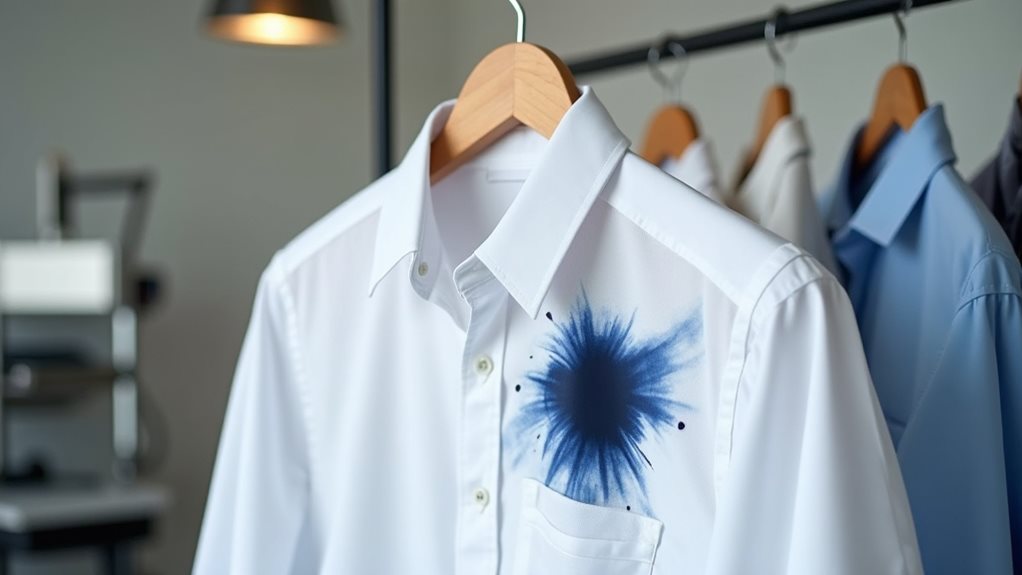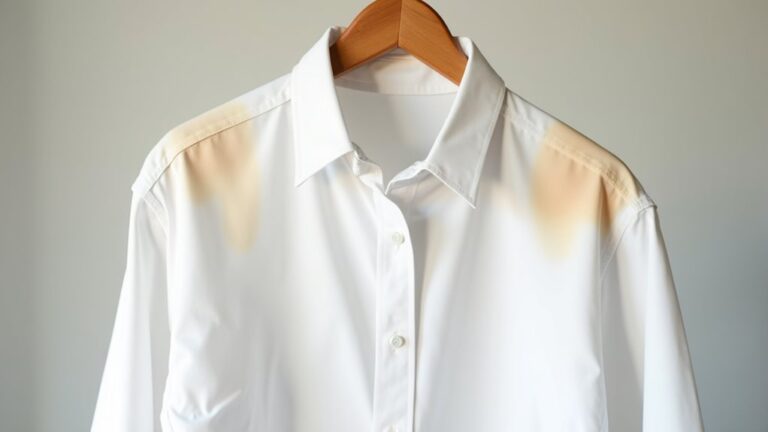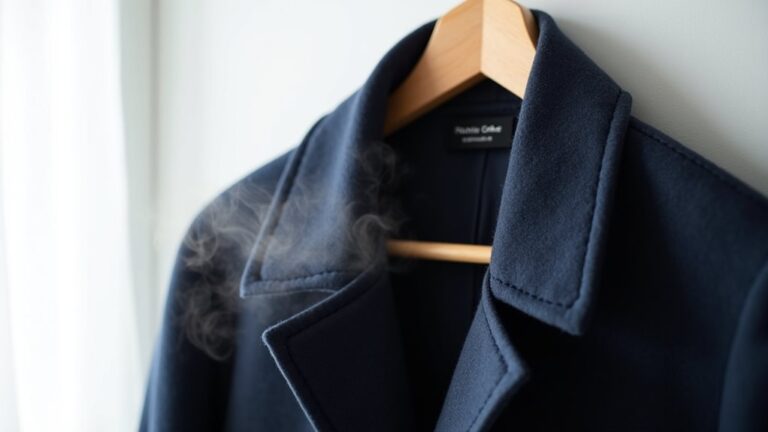Yes, dry cleaning can remove many ink stains, though your success depends on the ink type and timing. Water-based inks dissolve easily with professional solvents, while oil-based and permanent inks present tougher challenges. Fresh stains respond much better than older, set-in ones that have bonded to fabric fibers. Professional dry cleaners use specialized spotting agents and non-water solvents like perchloroethylene to break down ink molecules without damaging delicate fabrics, and understanding these nuances makes all the difference.
Understanding Different Types of Ink Stains
When I first discovered that stubborn ink blotch on my favorite white blouse after a particularly enthusiastic note-taking session, I quickly learned that not all ink stains are created equal.
That moment when your productivity turns against you and leaves its mark on your most cherished clothing pieces.
Understanding the type you’re dealing with can mean the difference between salvaging your garment and saying goodbye to it forever.
Water-based inks from fountain pens or washable markers are your best-case scenario for ink stain removal, dissolving relatively easily during the dry cleaning process.
Oil-based inks require specialized solvents due to their greasy nature, making them trickier but still manageable.
Permanent inks, however, live up to their intimidating name—these types of stains often resist even professional treatment, leaving you crossing your fingers and hoping for the best! 😅
The specialized chemical solvents used in dry cleaning are particularly effective at breaking down oil-based ink stains without damaging delicate fabrics like silk or wool.
Why Ink Stains Present Unique Challenges
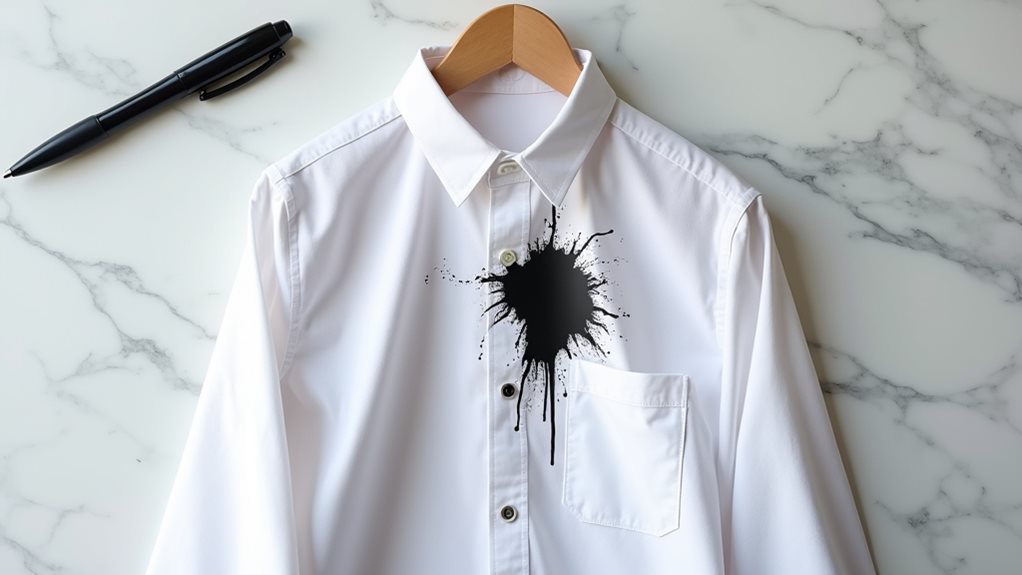
Although most stains follow predictable rules—blot, treat, and hope for the best—ink stains laugh in the face of conventional wisdom, spreading like gossip through fabric fibers the moment you touch them with anything wet.
These sneaky little troublemakers are particularly difficult to remove because they’re designed to be permanent, which explains why your favorite pen exploded on your white shirt instead of that old t-shirt you planned to toss anyway. 😅
The different ink formulations require specific approaches that most of us don’t know, and treating stains on delicate fabrics becomes even trickier.
That’s why professional dry cleaners use specialized spotting agents and techniques—they understand that what dry cleaners use can make the difference between salvation and saying goodbye forever.
Unlike oil-based stains that dry cleaning handles with ease, ink presents unique challenges because chemical solvents alone may not be sufficient to break down the complex pigments and binding agents found in modern ink formulations.
How Professional Dry Cleaning Tackles Ink Removal
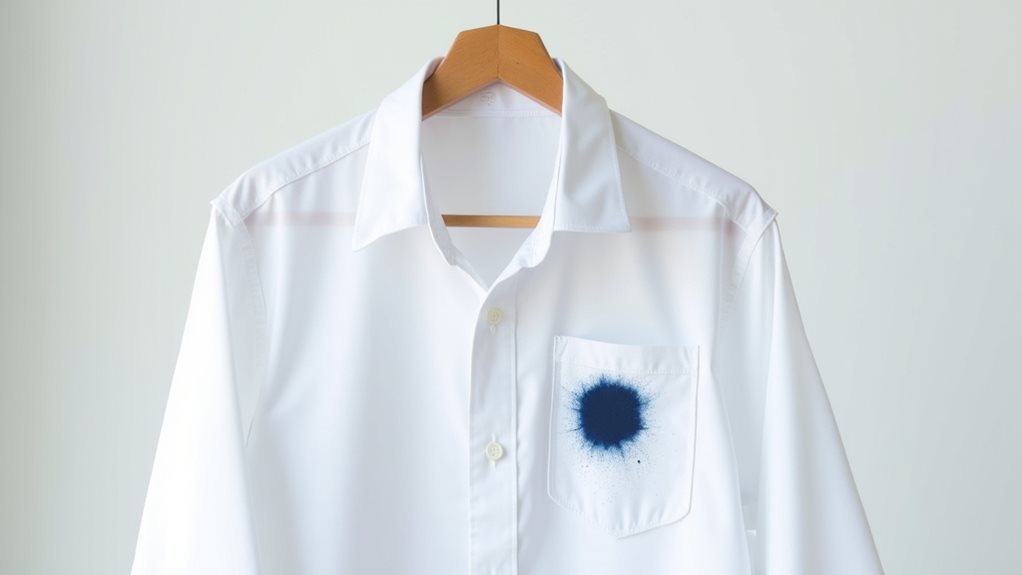
Professional dry cleaners approach ink removal like skilled detectives, armed with an arsenal of specialized spotting agents that would make your home laundry room weep with envy.
When you bring that ink-stained garment in, they’ll first identify the type of ink you’re dealing with, because water-based inks surrender much easier than their stubborn oil-based cousins.
Here’s where professional dry cleaning truly shines: their non-water solvents can dissolve ink compounds without turning your silk blouse into expensive tissue paper.
Professional dry cleaning solvents work their magic on stubborn ink stains while keeping delicate fabrics perfectly intact.
Those oil-based inks that laugh at your home remedies? They meet their match with advanced techniques that dry cleaners remove stains with daily.
The secret lies in immediate action and honest communication about what caused the mess—trust me, they’ve seen worse! 😊
However, keep in mind that success rates decrease significantly as ink stains age and become more permanently bonded to fabric fibers.
Specialized Solvents and Techniques Used by Dry Cleaners
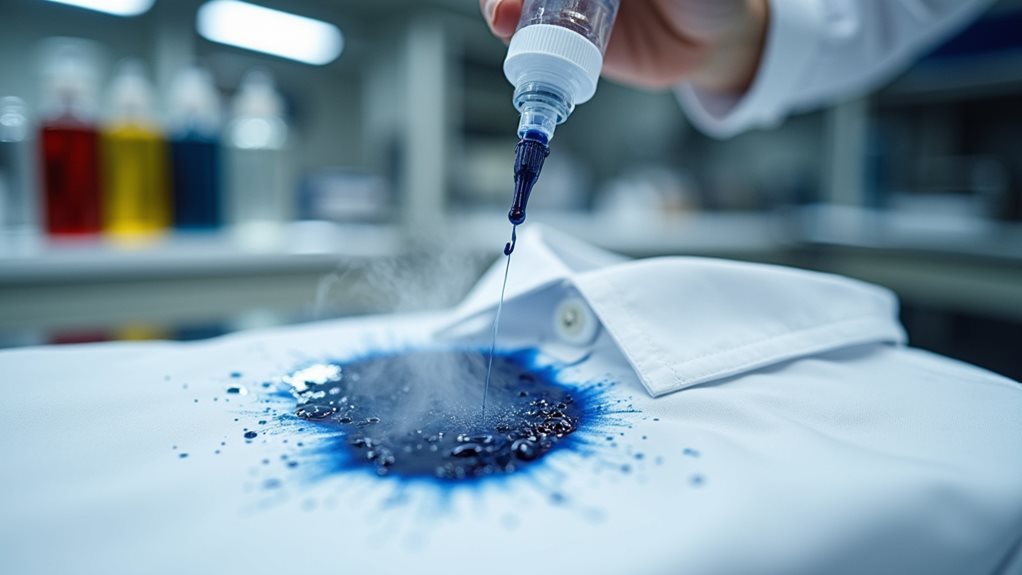
The chemistry arsenal that dry cleaners wield makes your home stain-fighting supplies look like toys in comparison, and honestly, it’s both humbling and fascinating to watch these solvents work their magic.
When you’re dealing with stubborn ink stains, these pros reach for specialized solvents like perchloroethylene, which can dissolve what seems impossible without harming your delicate fabrics.
They’ll assess whether you’re battling water-based or oil-based ink, then deploy targeted spotting agents that match the specific chemistry of your stain.
For protein-based stains, enzyme solutions literally digest the organic compounds, while their multi-step process combining heat, agitation, and solvent application maximizes removal efficiency in ways that’ll make you wonder why you ever attempted DIY solutions! 😅
Similar to oil stains, the success of ink removal depends on factors like stain age, fabric type, and whether any previous treatment attempts have made the stain more difficult to remove.
Factors That Affect Ink Stain Removal Success
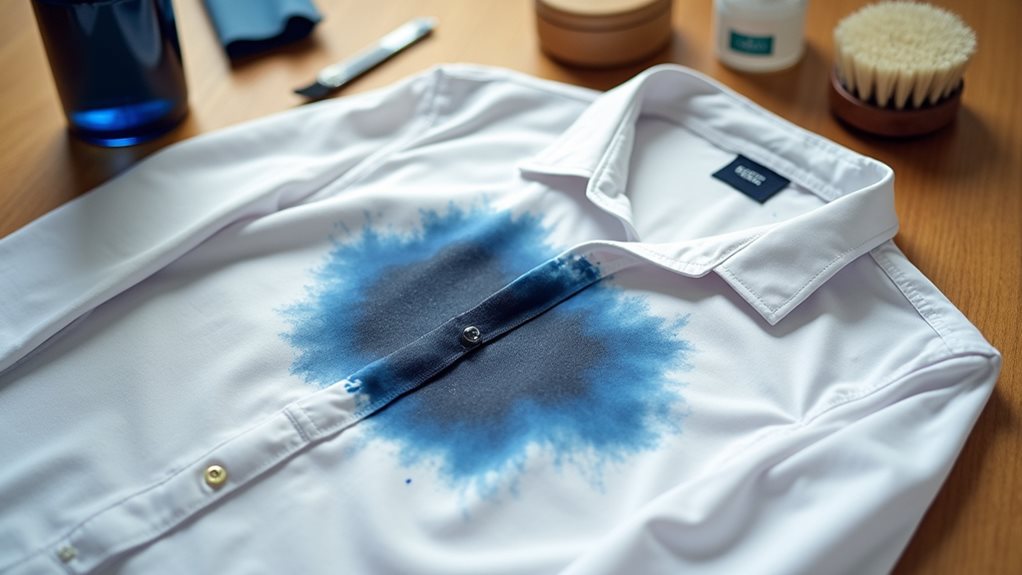
When I first discovered that not all ink stains are created equal, it was after watching my favorite silk blouse get completely ruined by what I thought was a simple pen mark – turns out, your success rate depends heavily on several key factors that can make or break the entire removal process.
The type of ink matters tremendously; water-based inks surrender easily while oil-based ones fight back stubbornly. Fabric composition plays a huge role too – delicate materials need gentler approaches than sturdy cotton.
Here’s where I learned my lesson the hard way: prompt action is absolutely critical! Professional dry cleaners understand this timing dance perfectly, using specialized spotting agents that match each specific ink type, which dramatically improves removal success when you act fast. Just like with sweat stains, fresh stains are always more responsive to treatment than older, set-in marks that have had time to bond with the fabric fibers.
When to Choose Dry Cleaning Over Home Remedies

You’ll want to choose dry cleaning over home remedies when you’re dealing with delicate fabrics like silk, wool, or vintage pieces that could easily be damaged by water or harsh scrubbing.
I learned this the hard way when I tried to remove ballpoint pen ink from my favorite cashmere sweater with rubbing alcohol, only to watch the fabric pill and lose its softness forever 😅.
Professional dry cleaners have access to specialized solvents that can break down ink molecules without compromising your fabric’s integrity, something your kitchen cabinet remedies simply can’t match.
Always point out the ink stain to your dry cleaning professional so they can apply specialized treatments specifically designed for that type of stain.
Delicate Fabric Protection
Although I’ve learned this lesson the hard way after ruining a gorgeous silk blouse with rubbing alcohol 😅, delicate fabrics like silk, wool, and cashmere require a completely different approach when it comes to ink stain removal.
You simply can’t treat these precious materials the same way you’d handle a cotton t-shirt, because their fibers are incredibly vulnerable to damage from harsh home remedies and aggressive scrubbing techniques.
When you’re dealing with ink stains on delicate fabrics, dry cleaners become your best allies for successful removal, since they possess specialized solvents and expertise to protect delicate materials during the stain treatment process.
Their professional assessment guarantees your treasured garments receive gentle, effective care that preserves both the fabric’s integrity and your investment.
The success of removing ink stains through dry cleaning depends on several factors, including how long the stain has been present and whether any previous home treatment attempts have set the stain permanently into the fabric.
Professional Solvent Effectiveness
While home remedies might seem like the obvious first choice for tackling ink stains, there’s actually a crucial decision point where professional dry cleaning becomes more than just helpful, but necessary for achieving the results you’re hoping for.
Professional dry cleaners wield specialized solvents like perchloroethylene that literally dissolve ink without driving it deeper into your fabric’s fibers, something your kitchen cabinet concoctions simply can’t match.
When you’re dealing with stubborn ink stains on delicate materials, these dry cleaning solvents work like precision instruments rather than sledgehammers.
I’ve learned the hard way that attempting to remove stains at home often leads to fabric damage or permanent discoloration – trust me, that expensive silk blouse deserves better than my amateur spotting attempts! 😅
The effectiveness of stain removal largely depends on immediate professional treatment, as waiting too long allows the ink to set deeper into the fabric fibers.
What to Tell Your Dry Cleaner About the Stain

When you walk into that dry cleaner’s shop, clutching your ink-stained favorite shirt like it’s a wounded bird, you’ll need to become a detective sharing vital evidence with your cleaning expert.
The type of ink that caused your mishap—whether it’s from a ballpoint pen explosion in your pocket, a marker accident during craft time, or that fancy fountain pen that betrayed you during an important meeting—makes all the difference in how they’ll approach the rescue mission.
You’ll also want to confess the age of the stain, its size, and any desperate home remedies you’ve already tried, because trust me, that midnight attempt with hairspray and dish soap might’ve made things trickier than you’d hoped.
This detailed information allows the professional to identify the stain type and apply the most appropriate pre-treatment methods for your specific situation.
Ink Type and Source
Before you hand over that ink-stained shirt to your dry cleaner, you’ll want to become something of a detective about the mess you’re dealing with, because the more specific information you can provide, the better your chances of getting that garment back looking pristine.
Start by identifying the ink type – was it water-based from a gel pen, oil-based from a ballpoint, or permanent marker? The source of the ink stain matters tremendously, since printer ink behaves differently than fountain pen ink.
Dry cleaners can then select appropriate cleaning approaches based on your fabric type and any previous attempts to remove the stain you’ve made at home, because trust me, scrubbing with dish soap tells them everything they need to know about what they’re working with.
Just as importantly, let your dry cleaner know how old the stain is, since fresh stains are significantly easier to remove than set-in ones that may require multiple treatments.
Stain Age and Size
As much as I wish ink stains existed in some kind of time vacuum where freshness didn’t matter, the harsh reality is that the clock starts ticking the moment that pen explodes in your pocket.
You’ll need to be honest with your dry cleaner about exactly when this disaster struck. Stain age matters greatly because older ink bonds more stubbornly with fabric fibers, making removal considerably harder.
Don’t downplay the size of the ink stain either – that quarter-sized blotch requires different treatment than a tiny dot.
Your dry cleaner also needs to know about any previous attempts you’ve made at removal, since these efforts can alter their cleaning strategy.
Being upfront about fabric type helps them choose the right approach without damaging your garment.
Previous Treatment Attempts
Since honesty builds the foundation of any successful dry cleaning relationship, you’ll want to spill every detail about your amateur stain-fighting adventures, even if they make you cringe a little bit.
Your dry cleaner needs to know exactly which cleaning products you’ve already tried on that stubborn ink stain, because some home remedies can actually set the stain deeper into the fabric fibers, making professional removal considerably more challenging.
Whether you dabbed it with rubbing alcohol, attacked it with hairspray, or went nuclear with bleach (we’ve all been there 😅), these previous treatment attempts directly impact your success rate.
The more chemicals that have touched your stain fabric, the trickier the removal becomes for professionals.
Limitations and Realistic Expectations for Ink Removal
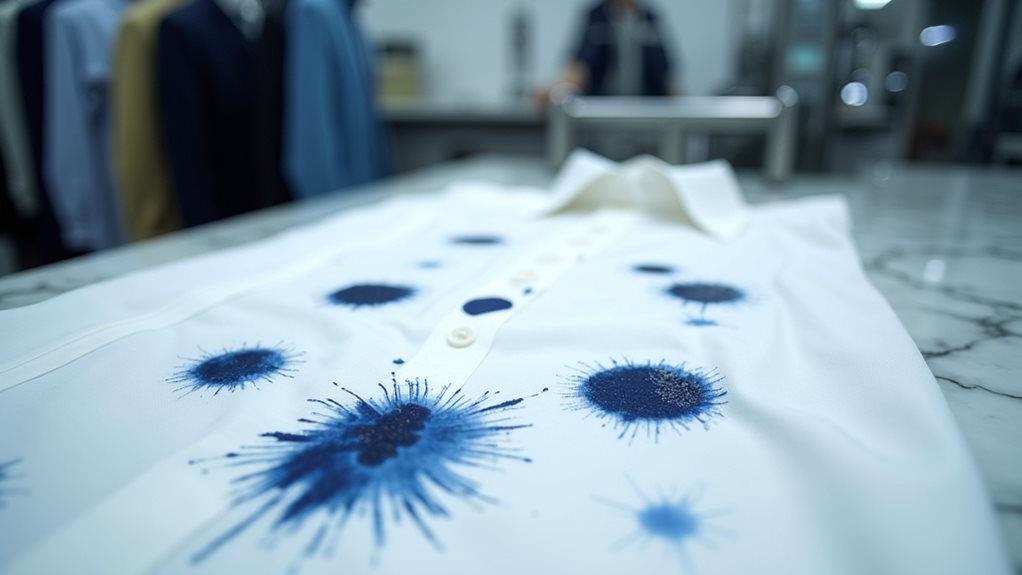
While dry cleaning can work wonders on many stubborn stains, I’ve learned the hard way that ink presents unique challenges that even the most skilled professionals can’t always conquer completely.
You need realistic expectations when bringing ink stains to dry cleaners, especially if you’re dealing with older ink stains that have had time to bond with fabric fibers.
Treatment speed makes all the difference – I’ve seen fresh spills fade beautifully while week-old disasters barely budge 😅.
Professional cleaners can often lighten stubborn marks considerably, but don’t expect miracles with permanent markers or ancient accidents.
Sometimes “good enough” beats “perfect,” and your favorite shirt might live to see another day, even with a faint shadow reminding you of past mishaps.

